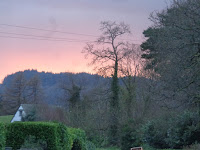Back in the fall, TJ and I had planned a camping trip in an English national park, but it got sidelined by work obligations. When we finally got a weekend long enough to revisit our plans, it was winter, so camping was no longer ideal. But it meant that we had more time to tack on a visit to a second outdoor attraction: Lake District National Park, known as the land of Beatrix Potter.
After driving all day -- very carefully in a blinged-out rental car on the left-hand side of the road -- we got to our base, Windermere, right at sunset (left). As we walked down to the lakeside, it was easy to understand how the environs had inspired Potter's books. And why she decided to settle in the area after her publishing success (and marriage to a local chap), spending her final days in the farmland around Castle Cottage. Ironically, Potter had no children to enjoy the stories she wrote; instead, she raised Herdwick sheep at Hill Top and Troutbeck Park farms. From the dock in Bowness-on-Windermere (right), you can catch a lake cruise to Wray Castle, where Potter vacationed with her family when she was younger.
Despite our last-minute planning, we landed a great place to stay, in the attic room of The Lamplighter, which provided a nice view of the area's grey-stone and thatched-roof structures (left). The establishment is known as one of the best dining spots in the region, and even from just our included breakfast, we could tell why (right).
Bellies full of bacon, we headed off through the Kirkstone Pass toward the northern part of the district (left). Quite a few people were taking advantage of the melting snowfall to hike up some of the highest peaks in the park. It was difficult to tear TJ away, but thankfully, it was too early for the Kirkstone Pass Inn to be open, so I was able to convince him to head on.
TJ's goal was to step into Scotland. Ultimately, we abandoned those plans, but at least we hit the border of an ancient empire: Hadrian's Wall. The 80-mile wall is mostly in ruins now, but the footprints of some structures remain, such as Poltross Burn Milecastle (top left). Milecastles were small forts constructed every, well, mile along the frontier. On the other hand, turrets -- like the one at Walltown Crags (top right) -- were watchtowers spaced every one-third mile along the wall. Even from the wall's remains (bottom), the feat of its construction is apparent: It took six years to build the 6-foot-wide and 20-foot-high partition.
The wall was paid for by Emperor Hadrian and built by British troops to keep the "barbarian" Pict and Brigante tribes out of Roman territory. It apparently is part of the inspiration for George RR Martin's "Game of Thrones" series, and at Housesteads Roman Fort (left), you can dress up like your favorite characters to re-create scenes from the TV show. Instead, TJ and I took advantage of the only opportunity along the Hadrian's Wall Path to walk right on top of what remains of the barrier (right).
After lingering too long at the UNESCO World Heritage Site, we decided Scotland wasn't in the cards, so we headed back to the Lake District, so TJ could try one of his favorite beers right from the source. The Black Bull Inn, home of Coniston Brewery, had many choices on tap, but TJ opted for his beloved Bluebird Bitter (top). The Coniston pub is a purveyor of old-school ales, but Hawkshead Brewery in Staveley had more modern styles on offer. TJ tried a Brodie's Prime porter with his huntsman's pie, and I had a Hop Black dark ale with my venison casserole (bottom left). Although he's a teetotaler, even Sage got into the pub action, sharing a table at The Stags Head with us (bottom right).
Sage was much more enthusiastic the next day, when we set off on the sunny path up to Orrest Head (left). The Outlying Fell was the first hill scaled by fellwalker Alfred Wainwright upon his setting foot in the Lake District. Many ramblers simply pass over the hill as they hike onto other destinations, including Kirkstone Pass (right).But we only had a little while to lap in the views of Windermere Lake before we set off for our second national park (left). We could just barely spy Ambleside -- a quaint, but perhaps more posh, town at the northern tip of the lake -- amid the High Fells (right).
On our way back south we stopped off in Skipton for lunch. The town once was known as Sheep Town because of its animal market, but now tourists are tended to by herding them onto steam-powered boat rides along the Leeds-Liverpool Canal (top left). The jaunts on the waterway pass by Skipton Castle, a well-preserved medieval castle and likely the namesake of The Castle Inn. The tower next to the pub isn't a castle turret but the steeple of Holy Trinity Church (top right). To sustain us for the rest of our day's journey, directions for which I am Googling, TJ fueled up with a Theakston Old Peculier while I warmed up with some tomato soup from the special Mother's Day menu (bottom).


















































